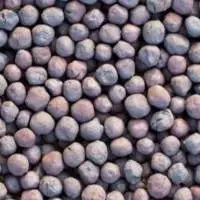
Our iron ore pellets and fines are made from magnetite and have high iron ore content pellets at around 67 percent concentration and fines over 70 percent. This means they have lower impact on the environment than competing pellets and products such as sintered hematite fines. Using pellets instead of sinter (slightly larger pieces of iron ore) in customers pig iron processes saves emissions at steel plants. The high concentration of iron combined with the carefully tested and balanced additives in our pellets also result in lower emissions in customers ironmaking processes.
Iron ores are the raw material used to make iron and steel. Iron ore production has significantly expanded in recent years, owing to increasing steel demands in developing countries, such as China. As the content of iron ore in deposits has deteriorated, low-grade iron ore has been processed. Iron ore concentrate is an output product from processed iron ores that have been milled (crush, grind, magnetic separation, flotation) to separate deleterious elements and produce a high-quality product. Sintering and pelletizing are economic and widely used agglomeration processes to prepare iron ore fines/iron concentrate for ironmaking use. The quality requirements of sinter and pellet, such as physical, chemical, and metallurgical specifications, depend on each ironmaking furnace, and those requirements influence the operation of the iron ore sintering and pelletizing plant. Researchers have usually focused on the effect of the chemical, physical, and mineralogical characteristics of iron ore on these steps and the consequences for sinter/pellet quality and sintering/pelletizing performance. The present Special Issue on Iron Concentrate Particles will summarize the progress achieved in the last five years.
IRON ORE PELLETS Fe 64% monthly volume 50,000 mt. Full specification is available on request, Iron Ore Pellets: Pellets are small balls of iron ore used in the production of steel. They are made with technology that uses the powder that is generated during the ore extraction process, once considered waste. The pellets are used in the production of steel which is used in the construction of bridges, cars, planes, bicycles, household appliances and much more. Product Type: IRON ORE PELLETS Fe (T) 64 % Si02 1.150 % Fe0 0.75 Max Ti02 0.021% Al2O3 0.319 % Ca0 1.170 % P 0.032 % S 0.031 % V205 0.004 % Cu 0.057 % N2O 1.290 % Mg0 0.069 % CCS 309 Size 16-19 mm - 7 % 09-16 mm -91 % 06-09 mm 2 % Tumbler Index- for above 6.3 mm 96.2 % - 95 % min Abrasion Index â??for 0.5 mm 3.8 % - 4 % max Sticking Index 950 deg C 20.1 % Bulk Density 2.17 % Compression Strength 270 Kg / Pellet / 150 kg / pellet Fines below 5mm (-) 5 mm 3 % max Reducibility index 55-65 % . NOTE: Interested parties please contact us with your LOI
Send us your requirements
Origin - India, South Africa Payment Term - LC For price, specification etc please contact us
We are ready to supply Iron ore pellets. For more detail and lab report contact us on whtsapp. Payment term LC at sight,usance, SBLC, Direct Bank transfer. Buyer are welcome to send enquiry. We will be happy to send you customized quotes.
Pellets are small balls of iron ore used in the production of steel. They are made with technology that uses the powder that is generated during the ore extraction process, once considered waste. The pellets are used in the production of steel which is used in the construction of bridges, cars, planes, bicycles, household appliances and much more.
Iron Ore Pellets: Pellets are small balls of iron ore used in the production of steel. They are made with technology that uses the powder that is generated during the ore extraction process, once considered waste. The pellets are used in the production of steel which is used in the construction of bridges, cars, planes, bicycles, household appliances and much more. Product Type: IRON ORE PELLETS Fe (T) 64 % Si02 1.150 % Fe0 0.75 Max Ti02 0.021% Al2O3 0.319 % Ca0 1.170 % P 0.032 % S 0.031 % V205 0.004 % Cu 0.057 % N2O 1.290 % Mg0 0.069 % CCS 309 Size 16-19 mm - 7 % 09-16 mm -91 % 06-09 mm 2 % Tumbler Index- for above 6.3 mm 96.2 % -� 95 % min Abrasion Index â??for 0.5 mm 3.8 % - � 4 % max Sticking Index @950 deg C 20.1 % Bulk Density 2.17 % Compression Strength 270 Kg / Pellet � / � 150 kg / pellet Fines below 5mm (-) 5 mm 3 % max Reducibility index 55-65 %
Iron ore pellets are indurated, spheres of ore with a high iron content and uniform quality. Pellet plants can produce two varieties of pellets: blast furnace pellets and direct reduction pellets (DR pellets). Blast furnace pellets are used in the coke-based blast furnace process, which is the most common method of producing hot metal (molten iron for steelmaking). Blast furnace pellets are delivered mainly to steel mills. DR pellets are used in the direct reduction processes to produce sponge iron, which is an alternative process route, as an initial stage from iron to steel. The DR process is primarily based on the use of natural gas and has become increasingly common in countries with access to inexpensive natural gas.


